Many of us have witnessed a child having a tantrum in public places. It is easy to judge children and their parents for such behaviors. However, not many of us would think about autism spectrum disorder (ASD) at those times. The explosion of anger and emotions accompanied with screams and other disruptive behaviors can be an autistic meltdown. So how to tell the differences of tantrum vs autistic meltdown?
Even though in many approaches there is no distinction between meltdown and tantrum and they are both considered as undesirable behavior, often parents and professionals use these terms to specify two different situations.
In this blog, we review 6 important points that can help us to differentiate a temper tantrum and a meltdown in a child/person with autism spectrum disorder. Furthermore, we give 5 tips to handle meltdowns and 4 ways to prevent them.
We will discuss:
- 6 key differences between tantrums and autistic meltdowns
- Does tantrum happen in children with autism?
- How can you say if your child has an autistic meltdown or a tantrum?
- What can I do when my child is having a tantrum?
- What can I do when my child is having a meltdown?
- How can I help to prevent meltdowns?
Tantrum vs autistic meltdown:
A tantrum is often a goal-oriented action. Often young children learn that by tantrums they can achieve a reward such as a wanted behavior or a desired object. Children often have a request and when it is declined, they learn that by throwing a tantrum they can frustrate their parents or teachers and reach their goal. As soon as the child achieves the goal, the disruptive behavior quickly ends, since there is no reason to display it anymore.
However, autistic meltdowns are not created as a reward request system. They are not limited to just children and they can happen at any age or situation. A meltdown is often caused by sensory overstimulation. Many people with autism have an oversensitivity to various stimuli such as sounds, smells, lights, etc. The oversensitivity can cause the person to get overwhelmed, which leads them towards having a meltdown. Meltdowns are often more severe and emotional, more long-lasting and more difficult to handle than tantrums.
As mentioned, tantrum often happens in younger children and as the child grows up, they become less and less frequent. However, autistic meltdowns are not age-related and they may happen at any age. Many autistic adults, especially the higher functioning ones, may learn some strategies to prevent meltdowns and cope with them.
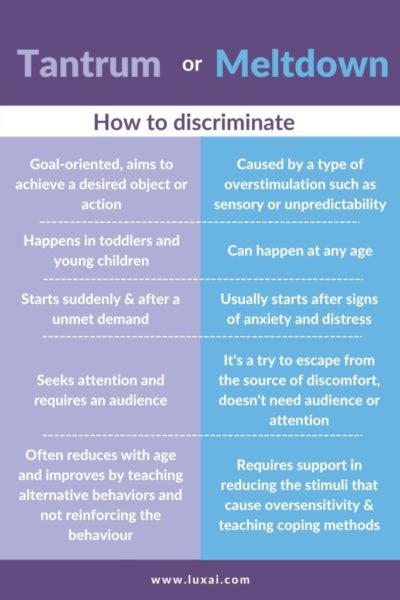
Main differences between an autistic meltdown and a tantrum
Does tantrum happen in children with autism?
Yes! Children with autism, similar to neurotypical children can also have temper tantrums. The challenge is to identify when a child is having a meltdown and when they are having a tantrum. This is very important, since the approach to these two situations is quite different, as we will discuss going forwards.
How can you say if your child has an autistic meltdown or a tantrum?
Tantrums and autistic meltdowns may look similar at the surface. They both can represent with screaming and crying, kicking, hitting, and breath holding. There are several points that can help us to differentiate meltdowns from tantrums. However, often the most important way to identify them relies on the parent’s experience. The parents know their children the best and over the time, often they are quick to discriminate meltdowns by experience.
Next, we go through 3 main points that can help to identify tantrum vs autistic meltdown:
1. Pay attention to the underlying situation and what has happened before the behavior:
A tantrum is a goal-oriented action, so there is always an unmet request before the tantrum. The child may be asking for a sweet or a toy, want to play games or not to leave the playground. Tantrums may happen in any situation if the child is tired or hungry or bored, but at any situation there is goal for the tantrum!
An autistic meltdown, however, is not related to a specific goal but rather caused by too much overload. It shows that the child is not able to handle the situation. There may be too much sensory stimuli in the environment, too much information, or the child just feels too much pressure from unpredictable situations and getting out of their routines.
Opposite to meltdowns, tantrums start quite rapidly and without a warning signal. The only clue that may help is having the child’s request denied. Often after a while, parents can identify these signals and predict that a meltdown is going to happen soon. Paying attention to these signals can be very helpful to remove the child from the overstimulating environment before it’s too late.
2. There are often signs of distress before a meltdown:
Autistic meltdowns often start with some warning signals. These signals can be very obvious or subtle. Based on the stimuli that is causing the sensory overload, children may cover their eyes or ears. Their body may become tense and they may try to move their body and hands as a self-suiting mechanism to reduce the distress.
Stimming is a self-stimulatory behavior such as rocking, pacing, or finger flicking. Many autistic children and adults use stimming as a self-calming technique. When you see an autistic child or adult who is flapping hands or rocking back and forth intensely, there is a good chance that they are feeling anxious and are under stress. Many meltdowns start after a short period of intense stimming. By paying attention to a child stimming, parents can be warned about a potential source of overstimulation.
It is important to mention that stimming is not always caused by distress. It can also be a natural response to excitement and happiness in a child with autism. In many cases, based on the experience, parents can differentiate a happy stimming from a nervous stimming.
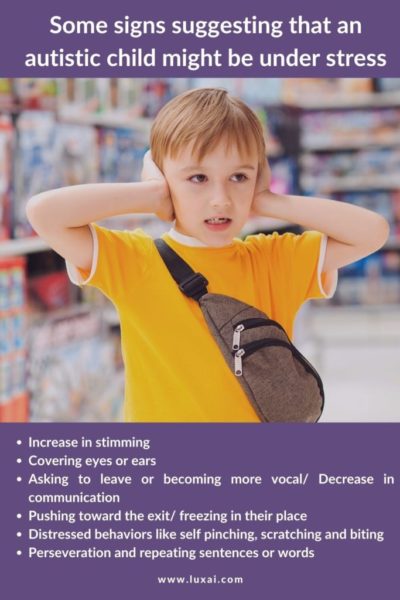
Signs indicating that an autistic child is going to have a meltdown
3. Is there an audience for the child’s behavior or not?
Tantrum is a way for children to get the attention of their parents and adults and to lead them to do something that the child wants. Therefore, tantrums always happen when there is an audience.
For example, if the child is alone or not with parents or direct caregivers, they would not have a tantrum.
Autistic meltdown, however, is not an act to attract attention and reach a goal. Therefore, they can happen in any situation and especially more often when children are away from their parents and they are dealing with new people and new situations. Based on the type of sensory sensitivity one individual may have, they can happen in various environments and they are not necessary coming after a request is denied.
What can I do when my child is having a tantrum?
Typical tantrums are a way that children learn to manipulate their parents to give them what they want. Children very quickly learn that they may get what they need by crying and screaming. Since there is a reward system for the behavior, each time the child reaches to their goal the behavior is reinforced. In many cases tantrums are self-limiting and they will disappear as the child grows. However, the reward loop can be broken faster, if the child learns that having a tantrum is not an effective way to attract attention and reach to their goals.
What can I do when my child is having a meltdown?
Sometimes an autistic meltdown is presented as just yelling and screaming. But sometimes they might involve self-injury and self-harm as well as biting and kicking. If the child is physically large, meltdowns become frightening and even dangerous.
As the child doesn’t have any control over their meltdown, it is often not possible to stop and control a meltdown in the process. In many cases the meltdown continues until the accumulated energy from the sensory overstimulation is drained. But there are many things that are important to do to support a child with autistic meltdown.
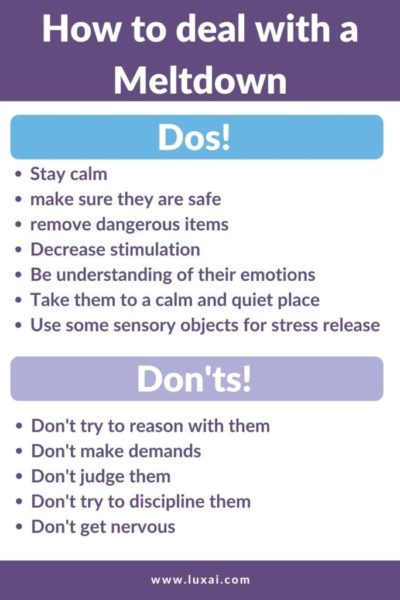
What to do and what not to do when your autistic child is experiencing a meltdown
You can follow these 5 tips to help a child experiencing an autistic meltdown:
1. Make sure the child is safe:
The most important point in helping a child or an adult who is having an autistic meltdown is to ensure their safety! Due to the magnitude of the sensory overload, there is always a possibility for the child to get hurt while having a meltdown. Therefore, we need to try to protect them and make sure they are safe. It might be necessary to remove the child from the environment and take them somewhere quiet, so they feel safe.
- Get them to a place where they feel safe. It is often the most effective way to deal with a meltdown.
- Get them to a corner or to the car, can be a good option when you are out.
- Try to hold them if there is a possibility of them hitting their head or injuring themselves.
2. Make sure you are staying safe as the child’s helper:
It is not uncommon for kids to unconsciously hurt others while having a meltdown. Especially when they grow up it can be very possible to hurt their parents who are trying to help them. So, make sure you won’t get hurt while you are helping them. If the child is physically large, often this requires more than one person to move the child to a calm and quite place without causing any injury.
3. Don’t try to talk to them and reason with them during a meltdown:
During the meltdown either the child is feeling an outburst of emotion showing as anger and frustration or they experience a complete shutdown and inburst. In both cases often during the meltdown, they would not be able to communicate, listen or pay attention. So, there is no point in talking to them and trying to explain things to them or try to tell them to calm down.
4. Try to stay calm:
It is easier said than done, but when a meltdown happens, we need to stay calm. Our anxiety and stress can make the situation worse and increase the intensity and the duration of the meltdown. By staying calm, we have a higher chance of being able to protect them and help them stay safe during the meltdown.
5. Don’t try to discipline them during a meltdown:
As we discussed before, autistic children have no control over the meltdowns. While they are experiencing a meltdown, it is therefore not a good time to try to teach them or remind them of anything. It can be very difficult for parents, but in this situation, it is important that you as a parent remember that the child is experiencing immense anxiety and is often scared. So, our anger and rigidity can only worsen their anxiety.

What can I do to prevent meltdowns?
Once a meltdown happens, there is not much to do. But there are many ways to prevent a meltdown and to support the child to have better self-regulation and calming down skills.
1. Know their triggers:
By paying attention to children with autism, we can find out a lot about what is causing overstimulation in them. By recognizing their triggers, we can be able to identify situations that can cause a meltdown and try to reduce their exposure to the situations that are triggering for them.
For example, if we are out in a crowded supermarket and our child is sensitive to noise, we can imagine them experiencing a meltdown caused by sensory overstimulation. We can also predict a possible meltdown if plans change, or we are going to do something out of the routine. By paying attention to the situations in which the meltdowns happen, we can identify the triggers and we can try to help children to avoid being exposed to these triggers. Also, if it is necessary to deal with a situation that might overstimulate them, we can be prepared to make interventions to reduce their overstimulation and reduce the exposure duration before a full meltdown starts.
2. Build a toolbox of calming down activities:
If you are at the point that you are predicting a meltdown, you can use many strategies to help your child to calm down. A first thing to do it to take the child out of the place that is making them feel overwhelmed. A warm bath, a quiet and dark place and some sensory tools that allow them to release stress can be good solutions to use.
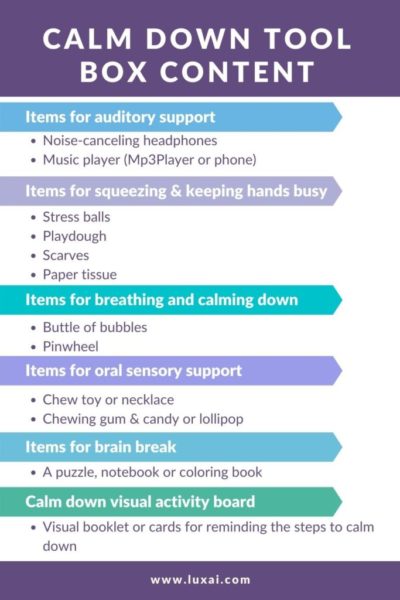
Calm down tool box for parents of children with autism to help their children prevent autistic meltdown
3. Prepare them for any change in the routine:
People with autism often have difficulties in dealing with even small changes in their routines. For example, holidays are fun for many of us, but many parents with autistic children experience more meltdown during holidays than usual. One way that can help children to get less anxious is to explain the situation and help them to get prepared for the change in the routine. If the child is verbal and understand spoken language, we can try to explain the situation and the plan change beforehand, so they can have some time to deal with the change of the routine before it happens. If they are more visual communicators, we can include the change in their visual schedule and try to use for example social stories that can help them to understand the situation and be prepared for it.

Using visual schedules can help children with autism to have a predictable plan and stay calm
4. When your child is calm, practice self-regulation and calming down activities:
It is very helpful to take your time and practice some structured activities that can help children to calm down and control their emotions. However, in order to be able to help children to learn how to calm down, we need to first make sure they can recognize their feelings, they can understand how each emotion is felt and triggered and to know what are the emotions that are negative or too intense and can cause meltdowns or inappropriate behaviors.
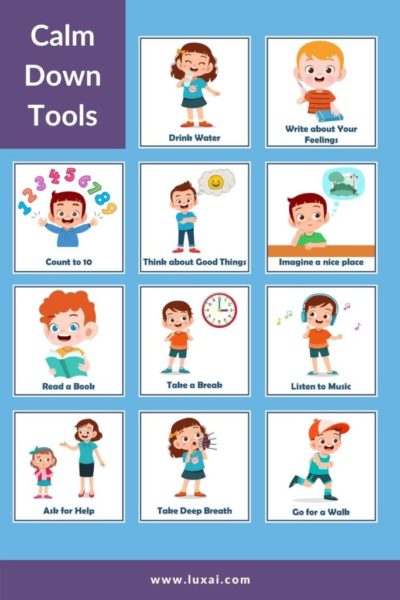
Calm down activities that can help a child with autism in regulating their emotions
Further readings
On our website, we have a set of blog posts that can help parents with children with Autism spectrum disorder. If you enjoyed reading our blog on tantrum vs autistic meltdown, we recommend to read our detailed blog here, explaining step-by-step activities for practicing emotion recognition with children with autism.
After practicing emotion recognition, you can follow these steps for promoting emotion understanding and discrimination of positive and negative emotions, as well as emotions that are too strong.
In our next blog, we provide practical steps and activities for helping emotion regulation and practicing calm down methods at home or at school. Read the blog here.



